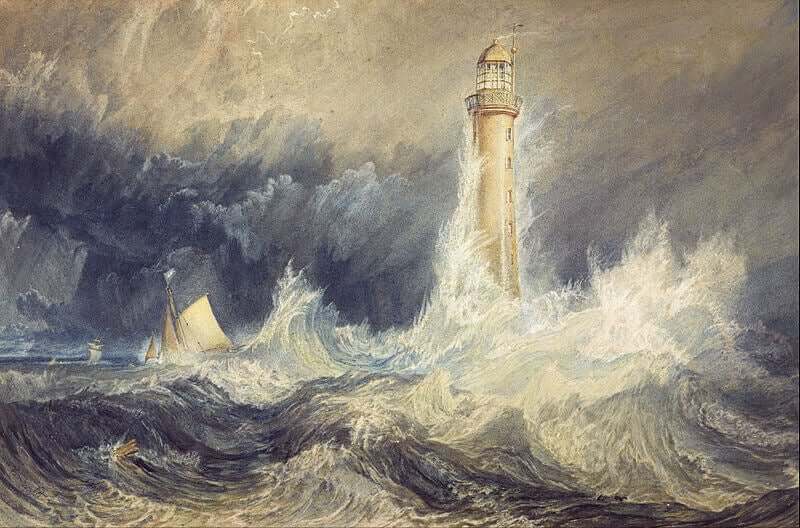Today we will talk about the biography of JMW Turner, an English painter specializing in landscapes and narrative representations, perhaps one of the most important precursors of French Impressionism, whose paintings, now very popular, are distinguished by their vivid colors and luminous atmosphere.
Joseph Mallord William Turner, known only by his surname, was a 19th-century British painter. At the age of 10, he was sent to live on the outskirts of London, middlesex, where he started high school, however, he quickly dropped out of school. At the age of 14, Turner was accepted as a student at the Royal Academy of Fine Arts.
- During his early years as an artist.
- Young Joseph devoted himself to the production of watercolors.
- Some of his works were sold to clients in his father’s hairdresser.
- So these clients were the painter’s first market.
Since he was a child, José preferred to travel and discover new lands during the holidays, instead of returning to his hometown, from this moment his taste for landscapes and nature began to prevail, however, his technique remains very similar to that of from other English painters of the time: quite rigid.
Just before the age of 20, in 1794, JMW Turner became acquainted with the works of Scottish painters such as John Robert Cozens, which helped him broaden his vision of landscape painting and produce more imaginative pieces.
Even for the expectations of the time, Joseph was an exceptional artist. At the age of 21, he began exhibiting at the Royal Academy each year, an honor reserved for a few. Despite this, Turner was never a man of refined and bourgeois manners. Flavors.
He always maintained the typical accent of London’s slums and did not like to wear garments considered elegant at the time. Besides, from a very young age he was a man of rude manners and sudden gestures. Although critics applauded the young painter, some of Turner’s contemporary artists mocked him for his stuttering.
In JMW Turner’s early works, around 1805, you can appreciate the painter’s original way of depicting landscapes, with an emphasis on luminosity, atmosphere and a dramatic and very romantic way of presenting the scenes.
The boundaries between heaven and earth in their landscapes have become increasingly diffuse, and topography has been sacrificed to make way for color. The effects of light have become the undisputed protagonists of his works.
In 1815, the great Tambora volcano erupted in Indonesia. Volcanic ash has affected the entire northern hemisphere of the planet. For at least three years, the sky has always seemed cloudy and the sunset has cleared.
According to research conducted by the Athens Academy in Greece, it is possible that the colors in the sky of Turner’s works are because of the high level of volcanic ash in the atmosphere.
JMW Turner, while painting a large number of pictures, also read avidly. He amused himself with Lord Byron and also with William Shakespeare.
Between 1815 and 1820, Joseph traveled through Europe visiting the great capitals of art, his stay in Italy definitively marked his style and the way he painted. After visiting Rome, the color of Turner’s works became even purer and brighter.
Turner has always been a man who prefers movement and action to a sedentary lifestyle. For this reason, I was constantly looking for ways to travel.
In the following years, Turner visited a lot of places in England and Scotland to find beautiful landscapes. After his father’s death in 1829, Turner preferred to stay close to the English coast, with its misty colors, wind and gardens.
In recent years of JMW Turner‘s biography, he has become much richer, more famous and more hostile than ever. Increasingly withdrawn and focused on painting as a form of expression, he did not cultivate many friendships.
In 1846 Turner lived in a small riverside house in Chelsea with a widowed wife, but he did not stop traveling. After many years in the country, he re-explored Europe. In the last 15 years of his life, Turner produced about 19,000 drawings and paintings.
Joseph Turner died in Chelsea in 1851 and, in his will, donated all his works to the English National Gallery, works that have survived over the years thanks to the efforts of the Tate Gallery in London.
The evolution of colors and light in Joseph’s paintings served as the basis for several researchers to suggest that the painter suffered from dementia. Experts indicate that the abstraction of his paintings can be interpreted through psychology. However, colors and diffuse light can indicate altered vision.
JMW Turner pioneered the study of light, color and atmosphere, and his works have inspired many French Impressionists.
However, unlike impressionists, Joseph always believed it was the duty of art to express topics of narrative interest, so Turner’s landscapes are not mere landscapes, they are mythological, historical and literary narratives.

